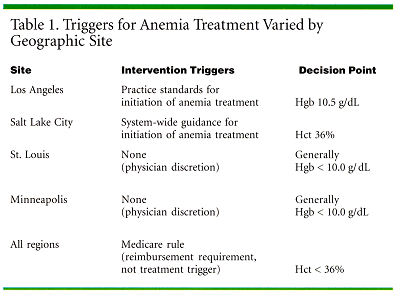Nurses Spot Gaps in Application of Clinical Guidelines for Anemia
WASHINGTON, DC-Recombinant human erythropoietin is accepted treatment for chemotherapy-related anemia, but a panel of four oncology nurses convened to review an evidence-based clinical practice guideline for anemia concluded that guidelines are not being consistently followed. The panel’s findings were presented by Denise Oseguera, RN, of University of California, Los Angeles, and Susan Ross, MD, of MetaWorks Inc., Medford, Massachusetts.
WASHINGTON, DCRecombinant human erythropoietin is accepted treatment for chemotherapy-related anemia, but a panel of four oncology nurses convened to review an evidence-based clinical practice guideline for anemia concluded that guidelines are not being consistently followed. The panel’s findings were presented by Denise Oseguera, RN, of University of California, Los Angeles, and Susan Ross, MD, of MetaWorks Inc., Medford, Massachusetts.
The panel identified major barriers to and benefits of implementing guidelines and pointed to clinic nurses as key to improving management of anemia in cancer patients. "Oncology nurses are often the first caregivers with the opportunity to assess anemia in cancer outpatients. The success or failure of implementation of any ‘global’ clinical practice guideline hinges on removing local barriers and emphasizing local benefits," Ms. Oseguera said. "In oncology clinic settings, nurses are the key implementersknowledgeable about practice-specific circumstances and equipped to champion process improvements."
Treatment Triggers Vary
The panel of four oncology nurses represented disparate practice settings in Los Angeles, Salt Lake City, St. Louis, and Minneapolis. "Outpatient oncology practice is heavily dependent upon nurses as both patient advocates and front-line care providers. Success of guidelines in this setting depends on identifying and addressing issues unique to nurses," Ms. Oseguera said.
The guideline for the treatment of chemotherapy-related anemia focused on the use of erythropoietin and was developed by a multidisciplinary panel following a systematic review of the literature through August 2000. The study to review the guideline was funded by Amgen.
The panel found that triggers for anemia treatment varied greatly at the different geographical locations (see Table 1). Panel members said that implementing the anemia guideline would improve care, reduce error, reduce direct and indirect transfusion-associated costs, improve adherence to chemotherapy schedules, and improve workflow.

Implementation Barriers
The nurses identified variable reimbursement rules, especially regarding whether treatment was given in the office or in the hospital, as a major barrier to implementation of the anemia practice guideline. Other barriers included excessive time required by nurses to pre-certify payment for erythropoietin and patient inconvenience (especially with regard to frequency of injections).
The nurses also cited "variable physician attitudes toward recognizing and treating symptoms of anemia and toward ‘soft’ measures of efficacy such as cognitive function and quality of life" as barriers, Ms. Oseguera reported. An equally important problem was institutional failure to assess all costs associated with anemia when considering interventions.
"The knowledgeable support of nurses, in addition to scientific advances such as the development of a new generation of erythropoiesis stimulating proteins to overcome dosing inconvenience barriers, may facilitate guideline acceptance," Ms. Oseguera concluded.